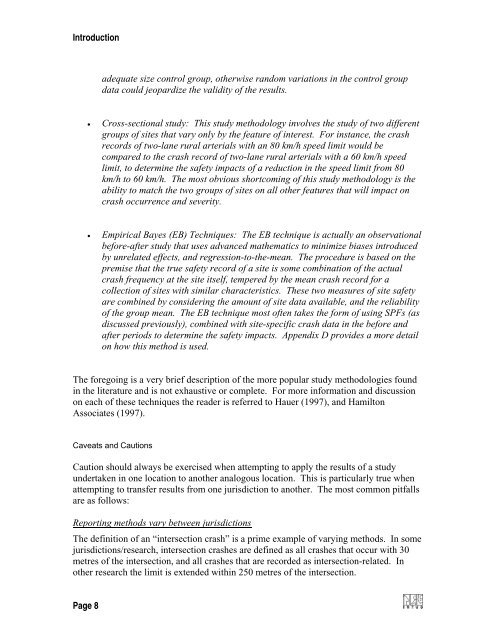Synthesis of Safety for Traffic Operations - Transports Canada
Synthesis of Safety for Traffic Operations - Transports Canada
Synthesis of Safety for Traffic Operations - Transports Canada
You also want an ePaper? Increase the reach of your titles
YUMPU automatically turns print PDFs into web optimized ePapers that Google loves.
Introduction<br />
adequate size control group, otherwise random variations in the control group<br />
data could jeopardize the validity <strong>of</strong> the results.<br />
• Cross-sectional study: This study methodology involves the study <strong>of</strong> two different<br />
groups <strong>of</strong> sites that vary only by the feature <strong>of</strong> interest. For instance, the crash<br />
records <strong>of</strong> two-lane rural arterials with an 80 km/h speed limit would be<br />
compared to the crash record <strong>of</strong> two-lane rural arterials with a 60 km/h speed<br />
limit, to determine the safety impacts <strong>of</strong> a reduction in the speed limit from 80<br />
km/h to 60 km/h. The most obvious shortcoming <strong>of</strong> this study methodology is the<br />
ability to match the two groups <strong>of</strong> sites on all other features that will impact on<br />
crash occurrence and severity.<br />
• Empirical Bayes (EB) Techniques: The EB technique is actually an observational<br />
be<strong>for</strong>e-after study that uses advanced mathematics to minimize biases introduced<br />
by unrelated effects, and regression-to-the-mean. The procedure is based on the<br />
premise that the true safety record <strong>of</strong> a site is some combination <strong>of</strong> the actual<br />
crash frequency at the site itself, tempered by the mean crash record <strong>for</strong> a<br />
collection <strong>of</strong> sites with similar characteristics. These two measures <strong>of</strong> site safety<br />
are combined by considering the amount <strong>of</strong> site data available, and the reliability<br />
<strong>of</strong> the group mean. The EB technique most <strong>of</strong>ten takes the <strong>for</strong>m <strong>of</strong> using SPFs (as<br />
discussed previously), combined with site-specific crash data in the be<strong>for</strong>e and<br />
after periods to determine the safety impacts. Appendix D provides a more detail<br />
on how this method is used.<br />
The <strong>for</strong>egoing is a very brief description <strong>of</strong> the more popular study methodologies found<br />
in the literature and is not exhaustive or complete. For more in<strong>for</strong>mation and discussion<br />
on each <strong>of</strong> these techniques the reader is referred to Hauer (1997), and Hamilton<br />
Associates (1997).<br />
Caveats and Cautions<br />
Caution should always be exercised when attempting to apply the results <strong>of</strong> a study<br />
undertaken in one location to another analogous location. This is particularly true when<br />
attempting to transfer results from one jurisdiction to another. The most common pitfalls<br />
are as follows:<br />
Reporting methods vary between jurisdictions<br />
The definition <strong>of</strong> an “intersection crash” is a prime example <strong>of</strong> varying methods. In some<br />
jurisdictions/research, intersection crashes are defined as all crashes that occur with 30<br />
metres <strong>of</strong> the intersection, and all crashes that are recorded as intersection-related. In<br />
other research the limit is extended within 250 metres <strong>of</strong> the intersection.<br />
Page 8
















